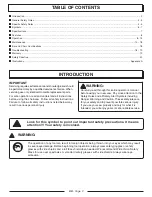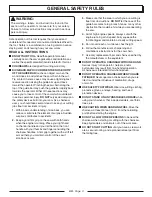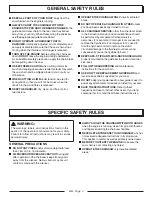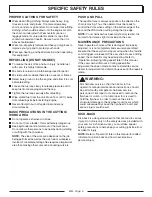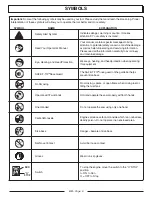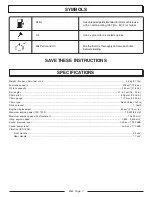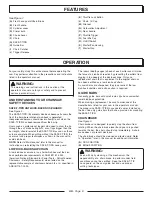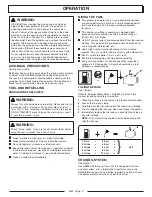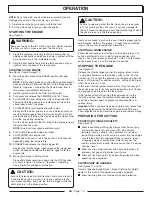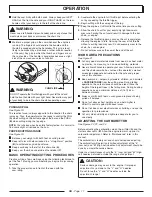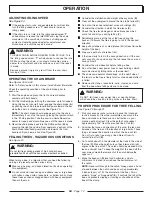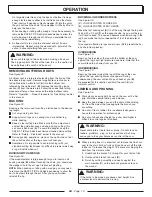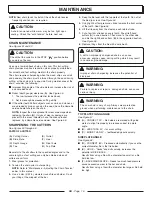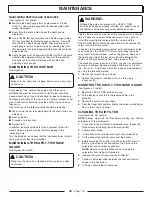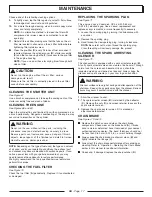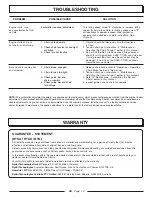
UK
- Page 13
OPERATION
On large diameter trees, stop the back cut before it is deep
enough for the tree to either fall or settle back on the stump.
Then insert soft wooden or plastic wedges (
F
) into the cut so
they do not touch the chain. Drive wedges in, little by little, to
help jack the tree over.
When bucking or felling with a wedge, it may be necessary to
remove the SAFE-T-TIP® anti-kick-back device to allow the
bar to be drawn through the cut. After you complete the cut,
reinstall the tip immediately.
5.
As tree starts to fall, stop the chainsaw and put it down
immediately. Retreat along the cleared path, but watch the
action in case something falls your way.
WARNING:
Never cut through to the notch when making a back cut.
The hinge controls the fall of the tree: this is the section of
wood between the notch and back-cut.
REMOVING BUTTRESS ROOTS
See Figure 32.
A buttress root is a large root extending from the trunk of the
tree above the ground. Remove large buttress roots prior to
felling. Make the horizontal cut (
A
) into the buttress first,
followed by the vertical cut (
B
). Remove the resulting loose
section (
C
) from the work area. Follow the correct tree felling
procedure after you have removed the large buttress roots.
Refer to “Operation – Proper Procedure for Tree Felling” earlier
in this manual.
BUCKING
See Figure 33.
Bucking is the term used for cutting a fallen tree to the desired
log length.
■
■
■
■
■
Cut only one log at a time.
■
■
■
■
■
Support small logs on a sawing stand or another log
while bucking.
■
■
■
■
■
Keep a clear cutting area. Make sure that no objects can
contact the guide bar nose and chain during cutting: this
can cause kick-back (
A
). To avoid the danger, keep the
SAFE-T-TIP® anti-kick-back device attached while cutting.
Refer to “Safety – Kick-back” earlier in this manual.
■
■
■
■
■
During bucking operations, stand on the uphill side so that
the cut-off section of the log cannot roll over you.
■
■
■
■
■
Sometimes it is impossible to avoid pinching (with just
standard cutting techniques) or difficult to predict which way
a log will settle when cut.
BUCKING WITH A WEDGE
See Figure 34.
If the wood diameter is large enough for you to insert a soft
bucking wedge (
B
) without touching the chain, you should use
the wedge to hold the cut open to prevent pinching.
NOTE:
When bucking or felling with a wedge, you may need
to remove the SAFE-T-TIP® anti-kick-back device to allow the
bar to be drawn through the cut. After you have finished,
reinstall the tip.
BUCKING LOGS UNDER STRESS
See Figure 35.
(
C
) LOG SUPPORTED AT ONE END.
(
D
) LOG SUPPORTED AT BOTH ENDS.
Make the first bucking cut (
E
) 1/3 of the way through the log and
finish with a 2/3 cut (
F
) on the opposite side. As you cut the log,
it will tend to bend. The saw can become pinched or hung in the
log if you make the first cut deeper than 1/3 of the diameter of
the log.
Give special attention to logs under stress (
G
) to prevent the bar
and chain from pinching.
OVERBUCKING
See Figure 19.
Begin on the top side of the log with the bottom of the saw
against the log; exert light pressure downward. Note that the
saw will tend to pull away from you (
A
).
UNDERBUCKING
See Figure 19.
Begin on the under side of the log with the top of the saw
against the log; exert light pressure upward. During
underbucking, the saw will tend to push back at you (
B
).
Be prepared for this reaction and hold the saw firmly to
maintain control.
LIMBING AND PRUNING
See Figure 36.
■
Work slowly, keeping both hands on the saw with a firm
grip. Maintain secure footing and balance.
■
Keep the tree between you and the chain while limbing.
Cut from the side of the tree opposite the branch you
are cutting.
■
Do not cut from a ladder: this is extremely dangerous.
Leave this operation for professionals.
■
Do not cut above chest height as a saw held higher is
difficult to control against kick-back.
WARNING:
Never climb into a tree to limb or prune. Do not stand on
ladders, platforms, a log, or in any position which may
cause you to lose your balance or control of the saw.
■
When pruning trees it is important not to make the flush cut
next to the main limb or trunk until you have cut off the limb
further out to reduce the weight. This prevents stripping the
bark from the main member.
1.
Underbuck the branch 1/3 through for your first cut (
A
).
2.
Overbuck the branch to drop it (
B
).
3.
Finish by cutting smoothly and neatly against the
main member (
C
) so the bark will grow back to seal
the wound.
WARNING:
If the limbs to be pruned are above chest height, hire
a professional to perform the pruning.


